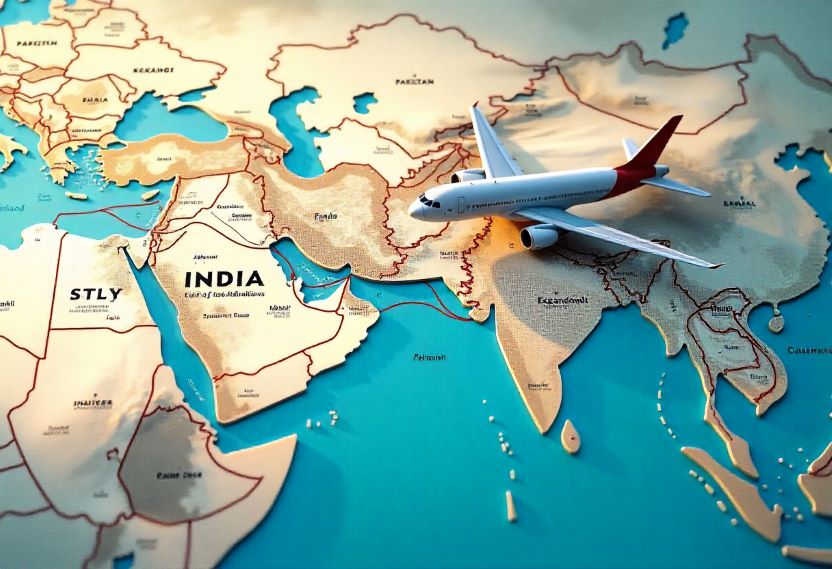Wednesday, July 23, 2025
In a new development for international air travel, India has extended its airspace ban for Pakistani aircraft up till August 23, 2025. Such a move, worrying to travelers, is taken for strategic and security reasons. The update was tweeted by Murlidhar Mohol, India’s Minister of State for Civil Aviation and Cooperation, on Tuesday. The imposition of these restrictions is expected to have major implications for air passengers travelling between the two countries and this would have an impact on the routing and scheduling of flights of airlines connecting Pakistan or flying out of Pakistan.
According to the recent updates, the airspace restrictions of the Notice to Airmen (NOTAM) end in August 23, 2025. As a result, Pakistani planes will not be allowed to fly into Indian airspace for the next two years, and it is anticipated that this restriction will drastically change air travel in the region. This extension is taking place amidst diplomatic tensions between the two neighbouring countries and the decision is being seen as India having maintained its security stand.
Background of the Situation
The latest ban on Pakistani aircraft has its roots in larger geopolitical and security issues between India and Pakistan. India had first banned Pakistani planes from its airspace in August 2019 amid escalating tensions. Since then, there have been several temporary extensions of the ban, the most recent of which has extended the restriction to 2025.
In a notice to airlines issued by India’s civil aviation authority, it said the restriction would be followed by all Paksitani aircraft, whether they were commercial or military flight. This has already had major repercussions for airlines operating to or overflying Pakistan on international flights.
Impact on Air Travelers and Flight Operations
The prolonged no-fly zones should generate a knock-on effect that affects numerous airways and disrupts the plans of some travellers. Airlines linking India and Pakistan and world wide routes flying through Indian air space are expected to have alternate routes. Therefore, travelers can expect travel delays, flight diversions and possibly cancellations.
Redirecting flights, that would otherwise fly through Indian skies, are considered to be one of the biggest fallouts of the extended curbs. These diversions usually lead to excess fuel burn, delays and passenger inconvenience. And many international flights that have hitherto overflown Indian airspace — for example, flights from the Middle East to South-East Asia may now have to find alternative routes, overcrowding the rest of the region’s air traffic space and adding to delays.
Additionally, airlines flying to and from Pakistan to other destinations in the world will have to find alternative air corridors as Indian airspace will no longer be available. Not only will these changes be a burden on passengers, they may well increase the cost of travel given the additional miles travelled and cost burden of airlines operations.
The longer ban also restricts direct flights for travelers from Pakistan — or for people traveling to or from Pakistan. Travelers could also face further delays or be forced to make connections via other international hubs. This might prolong their commutes and render their travel less seamless and efficient.
Pakistan’s Counteraction and Its Airspace Restrictions
This extension of India’s airspace restrictions comes shortly after Pakistan imposed its own set of limitations on Indian aircraft. On July 19, 2025, the Pakistan Airports Authority (PAA) announced a new NOTAM that banned all Indian aircraft from using Pakistani airspace. This includes all Indian commercial, military, and civilian aircraft, regardless of whether they are operated, owned, or leased by Indian entities.
Pakistan’s decision to impose these restrictions took effect on July 19 and will remain in place until August 24, 2025. The timing of these restrictions further complicates matters for travelers between the two nations and has prompted the aviation sector to reassess its operational plans.
With both India and Pakistan implementing reciprocal airspace restrictions, the situation has led to increased uncertainty in the region’s air travel sector. Passengers and airlines are left with no choice but to adapt to the evolving landscape of air travel, which could involve diversions, longer travel times, and potentially increased costs for airlines.
The Broader Implications for Regional Air Traffic
The ongoing airspace restrictions between India and Pakistan have broader consequences for regional air traffic, especially for international travelers flying between Asia, the Middle East, and Europe. For instance, flights to countries in the Gulf region, such as Dubai or Qatar, often pass through Indian airspace. As the restrictions continue, airlines must seek alternative routes, leading to flight path changes and delays.
Airlines operating out of both India and Pakistan are likely to face higher operational costs as they navigate longer flight routes. This could have a knock-on effect on ticket prices, making flights more expensive for passengers. In addition, the operational complexity of rerouting flights over long distances and through crowded air corridors could lead to further delays and challenges for the aviation sector.
As the situation continues to unfold, travelers are encouraged to stay updated on any new developments regarding airspace restrictions. It is advisable for passengers planning flights between India and Pakistan or those transiting through these airspaces to check with airlines for potential schedule changes or flight diversions.
Conclusion
India’s move to keep its airspace closed to Pakistani aircraft until August 2025 is a sign of the political and security challenges that still affect commercial flight in the region. With Pakistan’s reactive airspace restrictions complicating the matter further, passengers travelling from and to both nations could be landed with a serious dose of disruption, delay and additional out-of-pocket expense. Regional air traffic has already been affected, and travelers are encouraged to monitor the situation. These extended airspace restrictions are almost certainly going to be another blow to the already covered-over possibility of more normal air travel between these two countries for the immediate future, which is going to mean more hassles for passengers.
